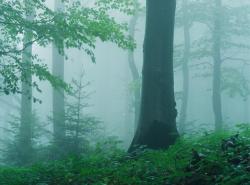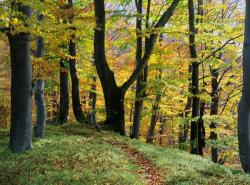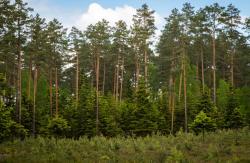 Asset Publisher
Asset Publisher
The State Forests National Forest Holding
The State Forests National Forest Holding is the largest organisation in the European Union managing forests, which belong to the State Treasury and celebrating its 90 anniversary this year.
Presently, we manage the area of one third of Poland's territory. Not long after the end of the Second World War, there was only 21 % of the area. Every year we plant 500 million of new trees, as we want Polish forests grow all the time.
Every year Polish foresters plant 500 million of trees.
85 % of nature reserves in Poland are located within the State Forests. 40 % of the forests managed by General Directorate of the State Forests are protected within the framework of European network Natura 2000. We fight against many threats: natural disasters, plaques of insects, trees' diseases, fires, pollutions, as well as poaching and vandalism.
We take care the forestry supplying the market with timber, as ecological and universal material, to be carried on in accordance with rules of balanced development (photography P.Fabjański).
One of our major tasks is making forests accessible to the society. We invite you to take advantage of these beautifully located within the forest wilderness holiday resorts, forester's lodges or guest rooms. That is for you, we create thousand kilometres of hiking trails, cycling paths or camping sites. All the above mentioned, you can find in service www.czaswlas.pl.
We also take care the forestry supplying the market with timber, as ecological and universal material, to be carried on in accordance with rules of balanced development. We obtain over 30 million of cubic meters of wood annually, twice as much as at the beginning of the nineties of the XX century.
Despite of this, the average of wood abundance per hectare of our forests is one fourth bigger than 20 years ago and 40% bigger than the average of European Union currently amounts.
In Poland in sectors connected with the forestry, there work about 375 thousand of people. It means that each 40 working Pole works in the forest.
In Poland in sectors connected with the forestry, there work about 375 thousand of people. It means that each 40 working Pole works in the forest. The sector of wood processing works out approximately 8 % of our GDP (Gross Domestic Product). Among others, thanks to the timber from the State Forests Poland is the 10 largest producer of furniture in the world, and the 4 largest furniture exporter.
The State Forests employ 25 thousand people. That way we are the 9 biggest employer in Poland. Among the largest companies in our country it takes 22 place in respect of its incomes and 11 place in respect of its profits. The value of assets, we manage, reaches 300 million zl. If we add social values, it will be worth one billion zlotych. We do not use money from the budget, but we earn money on our own to support the business. In spite of the financial crisis, since 2002, we continuously note down profits. Moreover, we pay taxes amounting 1,3 billion zl annually.
87 % of Poles think, the foresters are competent. We willingly share our knowledge of Polish forests, of their history and of nature values with the others. We publish books, periodicals, brochures; we also administer the website www.lasy.gov.pl . For children, the youth and teachers, we prepared internet service "E-lynx' Lynx Forest" (www.erys.pl). Our staff has supported schools in field of nature education for years. We also organise many actions to let people broaden their knowledge about forest, nature and ecology.
 Asset Publisher
Asset Publisher
 Asset Publisher
Asset Publisher
Lasy Nadleśnictwa Biłgoraj
Lasy Nadleśnictwa Biłgoraj
Nadleśnictwo Biłgoraj swoim zasięgiem obejmuje niemal 17 tyś. ha powierzchni leśnej co stanowi 97% całkowitej powierzchni nadleśnictwa. Sprawuje ponadto nadzór nad ok. 4,2 tyś. ha lasów niestanowiących własności Skarbu Państwa.
Strefa kontaktu Roztocza z Równiną Biłgorajską charakteryzuje się silnymi kontrastami krajobrazu, wynikających z znacznych różnic wysokości, które najbardziej podkreślają lasy rozciągające się u podnóża krawędzi. Rzeźba terenu Równiny Biłgorajskiej jest mało zróżnicowana. Dominują równiny tarasów akumulacyjnych. Monotonny krajobraz urozmaicają wały wydmowe długości kilku kilometrów i wysokości ok. 10 m. Urozmaicenie stanowią także doliny rzek, stawy, łąki, bagna i torfowiska. Na torfowiskach spotyka się w różnym stopniu zarastające torfianki. Na ogół są płytkimi zbiornikami nie przekraczającymi kilku arów powierzchni.
Największą powierzchnie zajmują gleby bielicowe, co stanowi ponad 60% powierzchni, kolejne 25% to gleby rdzawe. Takie podłoże wypełniają głównie bory i bory mieszane o różnym uwilgotnieniu, w których króluje sosna pospolita. Skład gatunkowy drzewostanów na siedliskach borowych jest zbliżony do przyjętych gospodarczych typów drzewostanów, natomiast na siedlisku lasu mieszanego wilgotnego (LMw) dąb zastępowany jest przez jodłę. Pod względem stanu siedliska dominują siedliska naturalne i w stanie zbliżonym do naturalnego, co stanowi 95% powierzchni nadleśnictwa. Siedliska zniekształcone występują na gruntach porolnych.
Charakterystyka roślinności strefowej wg. Matuszkiewicza obejmuje lasy liściaste Querco-Fagetea, głównie w związku Carpinion oraz kontynentalne lasy szpilkowe Vaccinio-Piceetea, przede wszystkim bory i bory mieszane sosnowe ze związku Dicrano-Pinion z pewnym udziałem jodłowych lasów związku Vaccinio-Piceion. Drzewostany nadleśnictwa tworzą 20 gatunków drzew. Gatunkiem głównym jest sosna stanowiąca 92% powierzchni. Gatunek ten osiąga przecietnie I-II bonitację, a drzewostany charakteryzuje się dobrą jakością hodowlaną i techniczną. Kolejnymi gatunkami pod względem udziału powierzchniowego są: olsza, brzoza i jodła. Pozostałymi gatunkami rodzimymi są: świerk, dąb szypułkowy i bezszypułkowy, modrzew, buk, klon jawor, jesion zwyczajny, grab pospolity, osika i lipa drobnolistna. Wśród gatunków obcego pochodzenia występuje dąb czerwony, czeremcha amerykańska i robinia akacjowa. W podszycie wśród roślin charakterystycznych występuje trzmielina, kruszyna i leszczyna. Rośliny runa to głównie borówka. Z lasem ściśle wiąże się także świat zwierząt. W lasach naszego nadleśnictwa można spotkać, jelenie sarny daniele, w terenach bardziej podmokłych łosie. Wśród drapieżników występuje wilk, jenot i lis, a z mniejszych m.in. łasica i kuna. To także teren lęgowy dla ptactwa.
Celem gospodarki leśnej jest zachowanie warunków do trwałej wielofunkcyjności lasów ich wszechstronnej użyteczności oraz kształtowania środowiska leśnego. Połowa lasów w naszym nadleśnictwie pełni funkcję ochronną. Pod tym pojęciem kryje się ochrona bioróżnorodności biologicznej, wody przed zanieczyszczeniem, gleby przed erozją i osuwiskami, środowiska naturalnego przed hałasem, powodzią czy wiatrem. 4% lasów nadleśnictwa pełni rolę ostoi zwierząt. Ponadto występują lasy nasienne stanowiące 0,13% powierzchni. Największą grupę lasów ochronnych stanowią lasy wodochronne, bo aż 84,4% powierzchni.


 fot. Paweł Fabijański
fot. Paweł Fabijański
 fot. Paweł Fabijański
fot. Paweł Fabijański
 fot. Paweł Fabijański
fot. Paweł Fabijański









